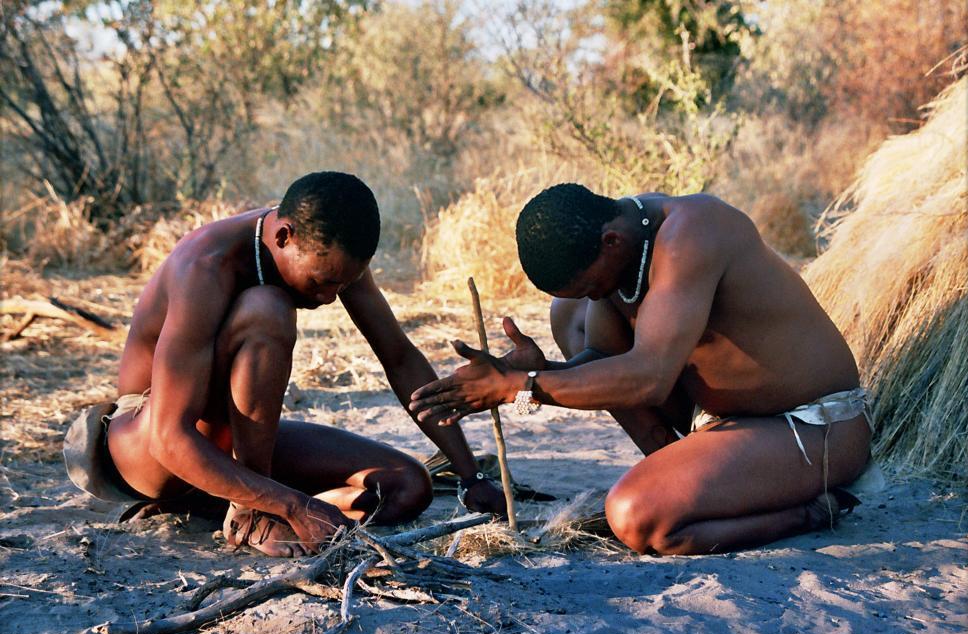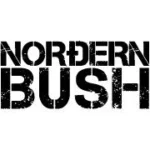In today’s society we have a few different groups and sub cultures that all take an interest in non-urban life as well as in nature and ways and methods for living and working in it. The three I will discuss here are bushcrafting, survivalism and prepping.
These three are all quite popular but only the last two have gotten real media attention and the meaning of the three terms are often confused, even by people taking an interest in them. This is perfectly understandable as there is much shared between them and especially the latter two share the contents of the popular bugout / everyday carry bags, being connected via the concept of a minimalistic kit to use in extreme emergency. It should also be noted that a bushcrafter may well find him- or herself in a survival situation due to injury or getting lost off-trail on a hike in remote areas. Also many bushcrafters prefer minimalistic and light gear as that carries its own particular freedoms.
So, due to that confusion, I will here expand a bit on how these three are defined. To be able to do so, however, we need too look at the underlying motivations and contexts for these interests, as these vary with each group and because of that the particular needs also vary. With that in mind I would also like to discuss these needs a bit, as they should decide your choice of gear and the set of skills you choose to learn and train.
Of course there is also a great overlap in both skills and gear, but some things are decidedly different and particular to certain contexts and it is important to know and understand this. The main differences that define them, as I see it, are eight in number;
- Ultimate goal
- The Law
- Time
- Location
- Moving & Navigation
- Preparation & Gear
- Natural resources
- Communication
So let’s look at this in more detail. First of all we need to understand the ultimate goal as that decides the approach and application.
Bushcrafting
Ultimate goal
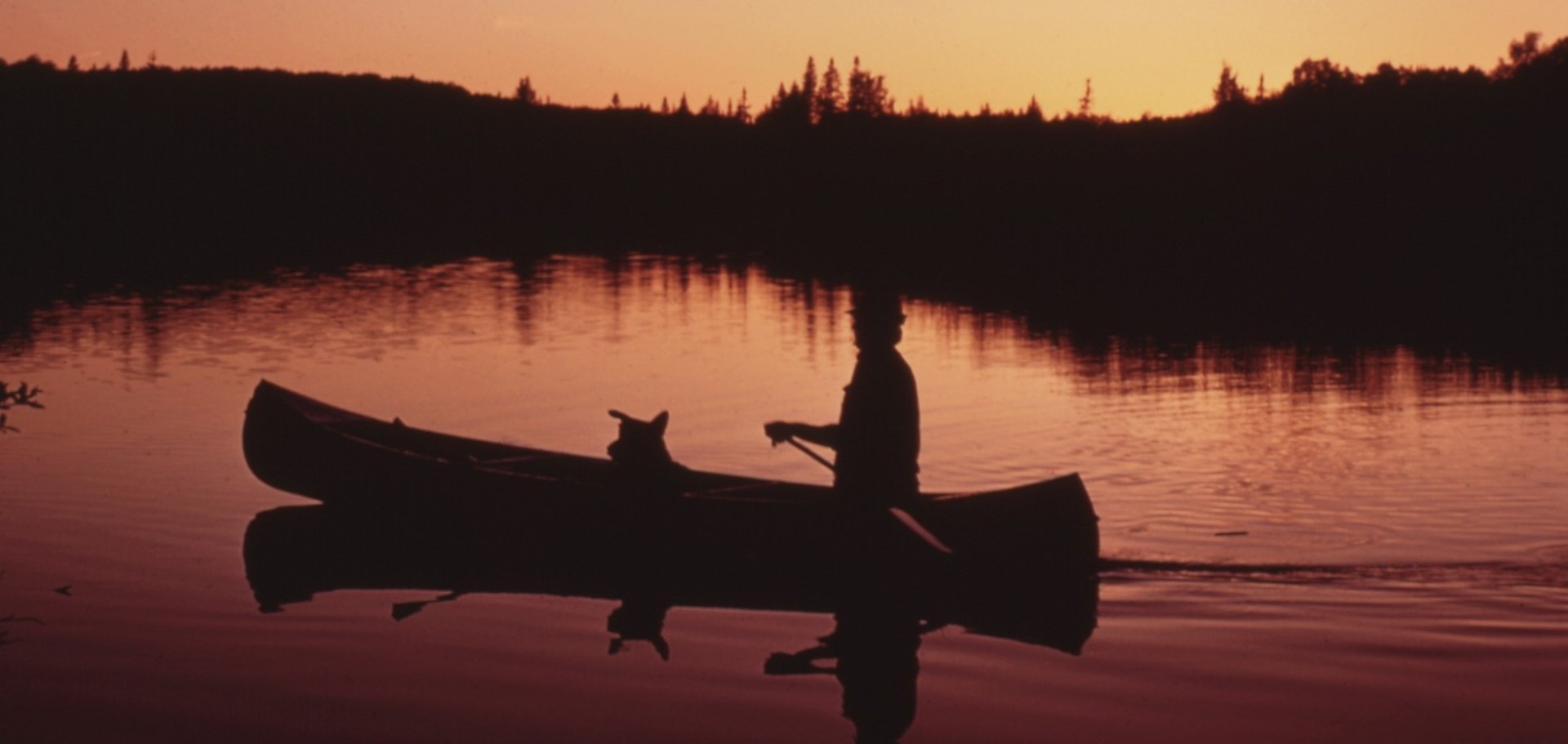
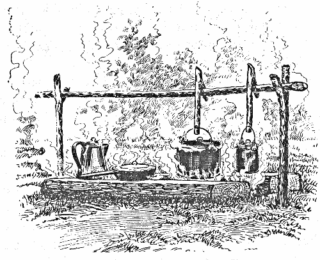
Camp fire for cooking
Bushcraft, or as it used to be called when it first got popular in then 19th century; woodcraft, is basically the knowledge and skills you need to live over extended periods of time in nature or the type of “simple” society we see in tribes or even pre-industrial villages. It is the life of the frontiersmen, the rangers and the woodsmen of days past, but while these skills and knowledge are still in use in various places, they are quickly disappearing with modern society and more and more with each generation.
The goal of bushcrafting is to be able to travel with relative ease, and to sustain oneself, in the wild, commonly for up to a few weeks, but ideally indefinitely, with what you can carry on your person, or on a horse or in a canoe. Bushcrafting includes building temporary shelters and fire places, originally used primarily for when working away from home, in the woods, fields, mountains and steppes, but nowadays more used for recreational purposes like hiking and camping.
Bushcrafting also includes building shelter of greater complexity all the way up to actual houses, with proper fire places and indoors access to water. It also includes making and maintenance of tools as well as finding and preparation of food. In this, there are great similarities to rural preppers.
For more examples of what I count into bushcrafting, I would point to this short article “What is bushcraft?”
Finally, the bushcrafters also tend to have a traditionalist streak, with a preference for old customs, natural resources and vintage gear. Fire making is often done with simple tools like fire steel, and canvas backpacks and bedrolls are popular, as is used and vintage military gear that has proven to be of good quality over several decades of use.
The Law
Since the nature of the three groups is so different, different laws also apply. Bushcraft and Prepping are both more or less long term activities that are regulated by laws and customs, where the latter may supercede the former in some cases, especially when the customs are very old.
One such example is bushcrafting and the Nordic Everyman’s Right. This regulates what one is allowed and not allowed to do in nature, even on private and state owned land, giving northerners great liberties in their outdoors lives. Still, certain things are forbidden and need to be respected for the benefit of everyone. Sometimes this comes in conflict with the desires of the bushcrafters who seek to learn to build shelters and prepare fire, but are by law forbidden to cut down living trees on anything but their own private property.
Time
Here time is controlled. You commonly choose to stay outdoors for anything from a few hours up to several weeks. You schedule your activities beforehand, during and after, normally taking the time you want and need for everything. Outside factors outside of weather doesn’t affect your activities much.
Location
With bushcraft the location tends to be closely connected to local culture and tradition. While modern society has meant a diffusion of manners of performing tasks, there is still a distinct cultural difference over the world, that connects to climate, flora and fauna. Consequently people may use e.g. axes and knives quite differently, and thus have them designed and sharpened in culturally very different ways, such as is the case with e.g scandi grinding and batoning.
Commonly the bushcrafter is quite familiar with the climate and terrain and well prepared and accustomed to living in it, even when the conditions change over time.
Moving & Navigation
This topic I already touched upon in the previous paragraph, but it includes more aspects as well. The means of transportation is also dependant on the topography of the area and can even include several types of transportation.
Good navigation skills are very important if you plan to go off-trail, but there are also many marked trails you can follow. Bushcrafters are generally not hikers though, and once in place they are comfortable staying there, more focusing on activities in camp and its near surroundings rather than on walking and exploring larger areas of nature.
Preparation & Gear
Preparation here is dependant on two things: First of all what you expect to be needing, even in case of minor emergencies like getting lost or injured. And second, what amount you can carry over the distance you plan to travel. The former is also dependant on the season and climate, while the latter is dependant on your means of travelling and the distance. Travelling mainly by car, on horse or bike, on foot or by boat or canoe means very different possibilities. Normally this means a fairly large amount of gear, up to 15-25kgs of gear and food carried in a backpack. However, as earlier noted many also prefer a minimalistic approach, carrying a minimum of gear as that carries its own particular freedoms.
Skills and knowledge can be learned slowly bit-by-bit and there is really no rush, nor an absolute requirement to learn more than fairly basic skills for raising a shelter and make fire so you can cook. In fact, using a single shelter type and knowing a couple of fire types and a handful of knots is quite enough for most of the time. Everything on top of that is for personal satisfaction and fun, as a hobby, but can of course be useful in a survival situation too.
For bushcrafters the gear can be divided into five different categories:
- Clothing
- Carrying
- Shelter
- Camp gear
- Personal equipment
I have already written an extensive article on this topic entitled A list of things you should get to better enjoy nature, but shortly this includes e.g. fire making kits, a water filter, a field kitchen, cooking utensils, saws, axes & various utility knives, a backpack, a tarp, tent or hammock, a sleeping mat and sleeping bag, binoculars, compass, first aid kit, a flashlight and fishing & hunting gear.
Knives in particular deserve their own little discussion so I will here focus on that topic for a bit.
The bushcrafter knife
When defining what a good bushcrafting knife is we need to consider a few aspects that are important:
- Roles to serve
- Edge
- Grip
- Use
- Reliability
Furthermore, for bushcrafting, the knife or knives will be used for many different activities; for example for fire preparation & fire making, building of shelter, food preparation and wood carving. No single knife is perfect for all these chores and a knife that is good for wood chopping and for use with fire steel is not as good for delicate or frequent carving.
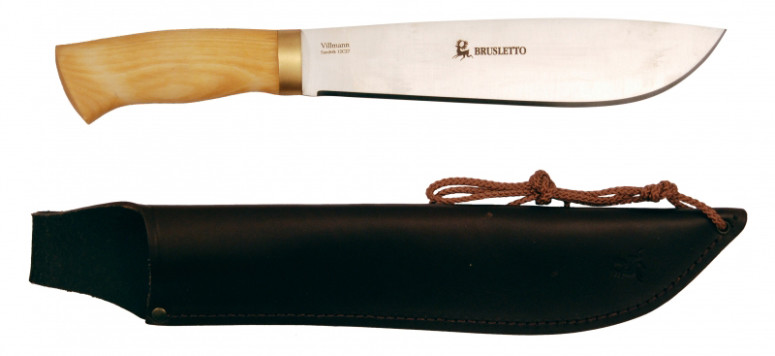
Brusletto Villman. A Sami Leuku-style large knife
Consequently many bushcrafters bring along 2-3 knives; one chopper for cutting large branches and for batoning of firewood, one medium or small knife, sometimes a neck knife, for tinder and food preparation and sometimes even a wood carving knife for carving spoons and forks. Hunters and fishers of course also commonly bring their own special knives for gutting and preparing their catch. Folding saws are also popular and in Scandinavia axes are more commonly used for preparing firewood than batoning is.
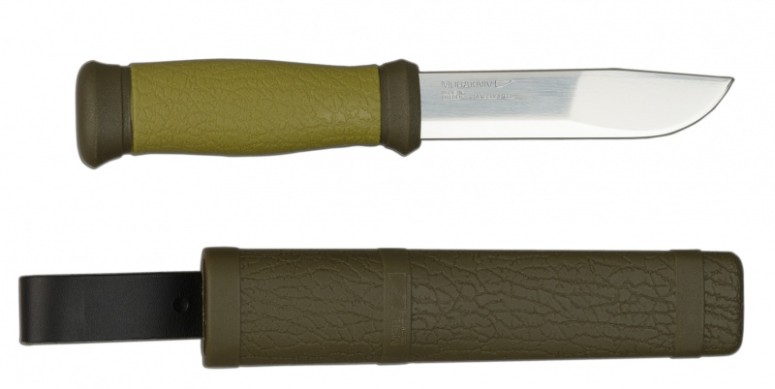
Mora Outdoor 2000
The edge should preferably be easy to regrind, but extreme edge retention is not as important. For that reason the scandi grind has become very popular as it is dead easy to resharpen even for inexperienced people. Bushcrafting knives are also commonly sharpened at an angle which makes the knife sharper, but somewhat less durable than survival knives. This makes them excellent for daily use.
The grip needs to be comfortable to use over longer periods of time as the knife is the tool you are using the most.

More Bushcraft Survival Black
The knife needs to be reliable, but also treated with consideration for its intended use. A simple 20 dollar Mora knife is quite enough and often beats far more expensive knives in performance for the most common chores.
Survival knives are not designed for bushcrafting and should therefore not here be used as the only knife although they might be sufficient for some of the needs.
Natural resources
Most bushcrafters will be bringing food with them, either readymade or to be cooked with a field kitchen or over a log fire. Some fishing is common, but can’t be relied on. Berries are tasty as is pine bud tea and fresh caught fish, but generally speaking bushcrafters don’t tend to eat much of natural food sources, although some basic knowledge of edible things in nature is common.
Quite frequent however, is knowledge of the characteristics of common types of wood to use for shelter and fire. Likewise, water filtering tools and techniques and risks concerning water quality is a fairly common knowledge among bushcrafters.
Communication
For many bushcrafters communication is a thing they are trying to get away from temporarily, seeking solitude, peace and quiet. Still, some means of communication in case of emergency is good. At a minimum a cell phone with good coverage should be brought for regular hikes. A satellite phone, a personal locator beacon or satellite emergency notification device can be worth considering for the somewhat more risky environments like mountainous regions or bear country.
Survivalism
Ultimate goal
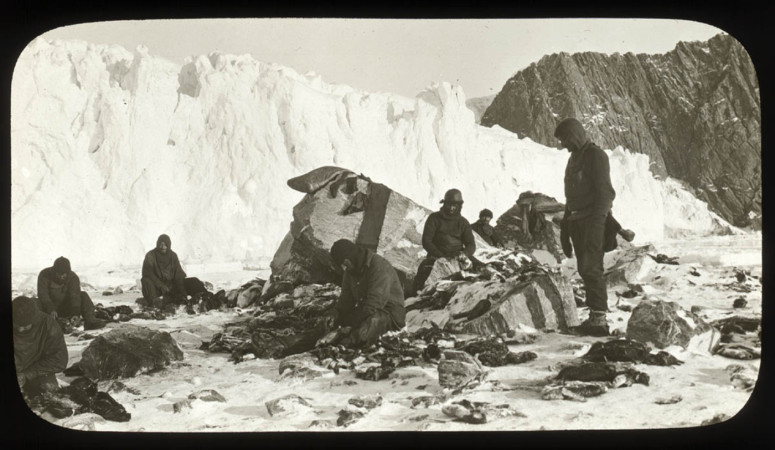
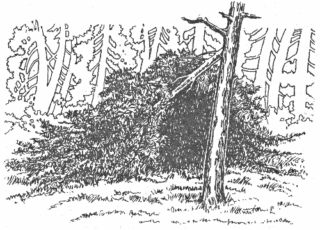 Survivalism revolves around escaping with as little harm as possible from an unexpected emergency or managing extreme conditions one has submitted oneself to intentionally, often as preparation for an emergency. Think a Special Forces Medical Sergeant and you are getting close.
Survivalism revolves around escaping with as little harm as possible from an unexpected emergency or managing extreme conditions one has submitted oneself to intentionally, often as preparation for an emergency. Think a Special Forces Medical Sergeant and you are getting close.
Thus it includes a lot of adaptability and improvisation, sometimes scavenging materials from a wreckage, signaling to others, moving through difficult terrain and circumstances, finding your way back to civilization. It of course also includes building of temporary and crude shelter, making fire using a knife or no tools at all, thus being capable of surviving for anything from a day to years in the most primitive conditions.
Still, many survivalists like to be prepared for an emergency and carry Every Day Carry kits which contain prepared materials like cotton balls or tampons with vaseline for fire making and similar modern items. This makes the group less traditionalist than the bushcrafters, combining preparedness with pragmaticism.
The Law
Survivalism here again is different in nature to bushcrafting, since it commonly focuses on a temporary emergency with potential risk of life. While still regulated by law, the situation is also generally considered judicially and special exceptions are made because of the special circumstances forcing the actions. In extreme cases survival measures in conflict with the law include acts of cannibalism, but far more common is theft or damage of property.
Time
With survivalism time is oftentimes not initially controlled. An accident comes suddenly and given the common lack of resources time is a hugely important factor. The Survival Rule of 3, for 3 minutes without air, 3 days without water and 3 weeks without food, generally applies and should dictate your actions. The choice of staying in place and signaling for assistance or strive to travel to safety depend on this. At some point you may be forced to chose the latter option.
Location
Like with time, location in actual survivalism is often not controlled, unlike in survivalist training where it is. Consequently, there is not necessarily any cultural or traditional aspect with survivalism, although that of course is still the most common context, simply because most emergencies happen in daily life. However, the location isn’t chosen, but given, and may well be an exotic and little known one, offering particular challenges through that. The same is of course true for climate and weather, as well as flora and fauna. This requires extra ingenuity and creativity, but also more concern and acting with more precaution than in known environments.
Moving & Navigation
Moving here usually means on foot, unless you can find some other means in abandoned places, like an old bike in an old barn etc, or alternately, can build an improvised raft by which you can travel down a stream or river. This however can be dangerous as it carries a risk of breaking bones on submersed and unseen rocks. It also cools you down drastically and thus is only suitable for warmer temperatures. Moving is therefore normally slow, far slower than people who are unused to travelling larger distances on foot and especially off-trail often realize, and returning to safety may take many days in worst case scenarios, despite taking just minutes by car.
Navigation can be very difficult as an emergency by nature often means uncertain conditions and may happen in areas unknown. Having just a vague and general idea of where the nearest chance of safety is is not uncommon and mistakes and disappointments are common under such circumstances.
Preparation & Gear
With survivalism, preparation focuses on two things, learning survival skills for emergencies, and on carrying a minimalistic kit to be used under such circumstances. Oftentimes it is focused on single person survival, but may also include group activities. It normally includes a knife, some simple fishing gear, fire making kit, heat-reflective survival blanket and some cord, but can also include arrowheads, medical kit, water filters and more, fit into a bag or pouch that can be carried comfortably every day. For some it is a natural and important thing to always bring, due to work in remote areas where a car breaking down can be potentially life threatening. Of course a satellite phone here would be one of the best items to bring, although expensive.
Survivalism can still be learned as a hobby though, and is a wise preparation for everyone, as it might save the lives of both yourself and others.
For a survivalist the type of gear is different to the bushcrafter, not least since there is so much less of it. The gear needs to fulfil the most basic needs and be very, very reliable, but also versatile, not being too specialized for any particular task. For this reason multitools of various designs are very popular.
Knife features
Again we need to consider the main aspects of what defines a good knife, as these are quite different between the three groups.
A good survival knife is not perfect for any single task, but it will be good enough for many. Like with bushcrafting, a survival knife is used for fire preparation and making, for building of shelter but also for prying things loose or open, breaking or hammering things, for making traps for game, for hunting, skinning and butchering, possibly even for first aid. The key words here are improvisation, versatility and reliability.
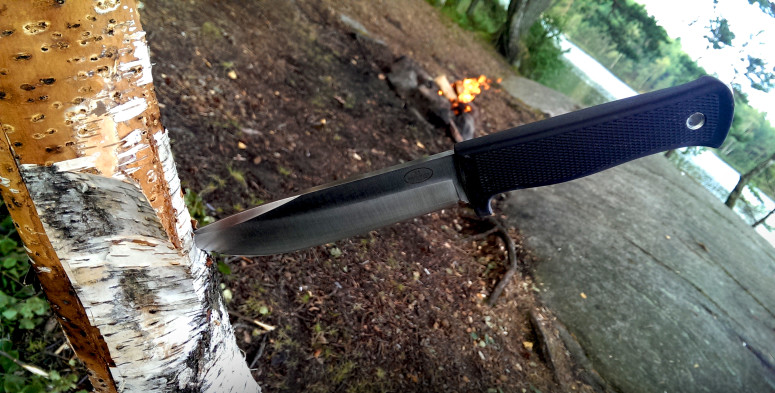
Fällkniven S1
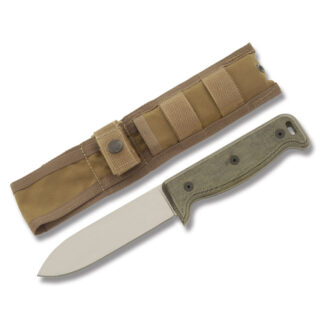
The spearpoint shaped OKC Blackbird
Some like their knives to have the shape of a spear point and with holes that make it easy to attach the knife to a staff with paracord, transforming it into a spear, not just for hunting, but for cutting down fruit from trees. Most commonly though, survivalists just want a simple and really sturdy and durable knife of more traditional shape.
The blade should not have a sharpened or thin back edge as that makes it difficult to baton well. It needs to be fairly large, again to alleviate batoning of firewood. And it needs to be full tang and of provenly good steel quality, hardness and thickness, so you don’t risk breaking it.
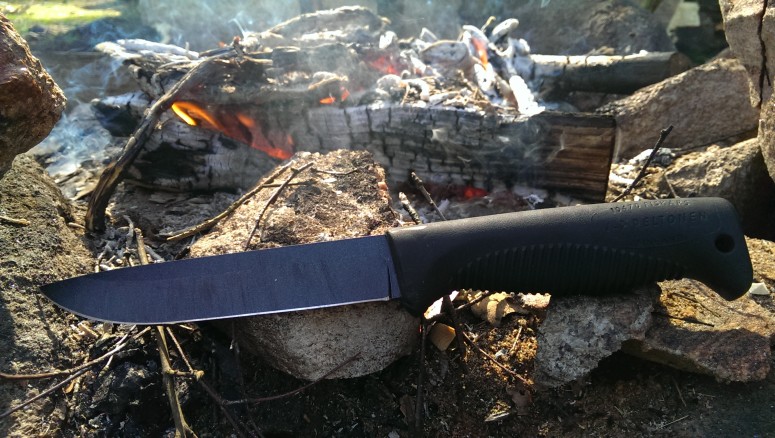
The Peltonnen Sissipuukko (Ranger Knife)
Edge retention is here important as sharpening the knife regularly is not something you wish to waste time on in an emergency situation. It also needs to be able to take a good beating without breaking as you only have a single knife to rely on for many demanding tasks. The grip comfort is less important as you are not expecting to use it over a very long period of time, but it needs to be safe so you don’t slip and cut yourself.
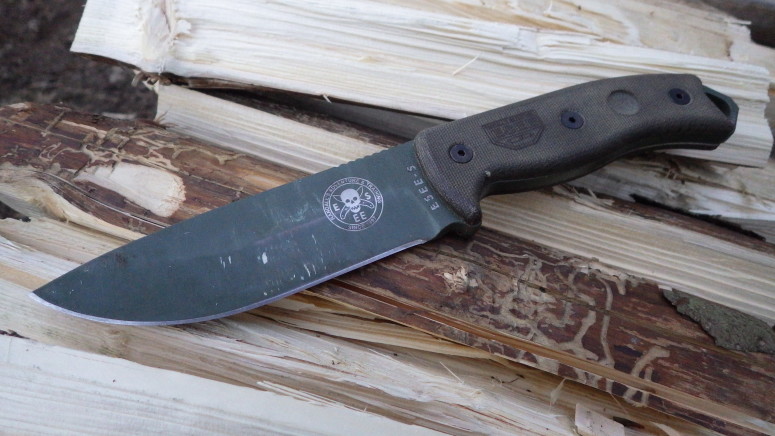
The beastly ESEE 5
One recommended maker of excellent survival knives are ESEE Knives, and especially their ESEE-5 and ESEE-6 which we have both reviewed in our review section. Another maker of brilliant survival knives is Swedish Fällkniven and their A1, S1 and F1 models which again we have reviewed here.
Natural resources
For the survivalist this, alongside of navigation, is the most important skill set and knowledge to learn. Clean water, trapping & fishing and finding nutritious and medical plants in nature is vital to know as there will likely not be any other sources for these basic needs, for an unknown period of time, and without knowing it your life is at risk. In large parts of the world, trapping and fishing is very hard as there is little to catch and consequently for many finding edible plants must be a priority. Fishing with nets or fish traps as well as bird catching should be considered though, as these are often far easier and since birds are common in most places. In more extreme situations anything edible of course needs to be used, even things not considered very appetizing, like insects. This distinctly separates survivalists from the other two groups. Cleaning water by simple means using improvised carbon filters and boiling it should be basic knowledge.
Not only shelters but also means of keeping warm by getting off the cold ground and using natural insulation, using fire radiation, body heat and movement are also on the list of basic things to learn, as is energy conservation.
Communication
Quite unlike the solitude seeking bushcrafter, this is one of the most important acts for the survivalist; to communicate the serious situation and his or her whereabouts and movements. The type of communication will often depend on whether you decide to stay in place and wait for help, which is often a better choice, or if you decide to leave your first location, seeking safety.
Regardless, a powerful whistle should be included in the kit, as shouting for help is too weak and exhausting. Colourful and bright, perhaps reversible clothes that can be seen from large distance in nature is worth considering. A satellite phone is of course great, but expensive. Learning to use a signaling mirror and to create and exploit smoke from fire should in any case be learned.
Finally knowing the common distress signals with groups of three; three fires, three piles of rocks, in a triangle, three shots from a firearm, three whistle blasts, three flashes of light, then a pause for a minute and then repetition, as well as learning the SOS signal of three short, three long and then three short signals is of course a given. A survivalist will also know to make large wood or stone arrows on the ground to signal the direction he or she is leaving for when seeking safety, to aid rescuers in locating them.
Prepping
Ultimate goal
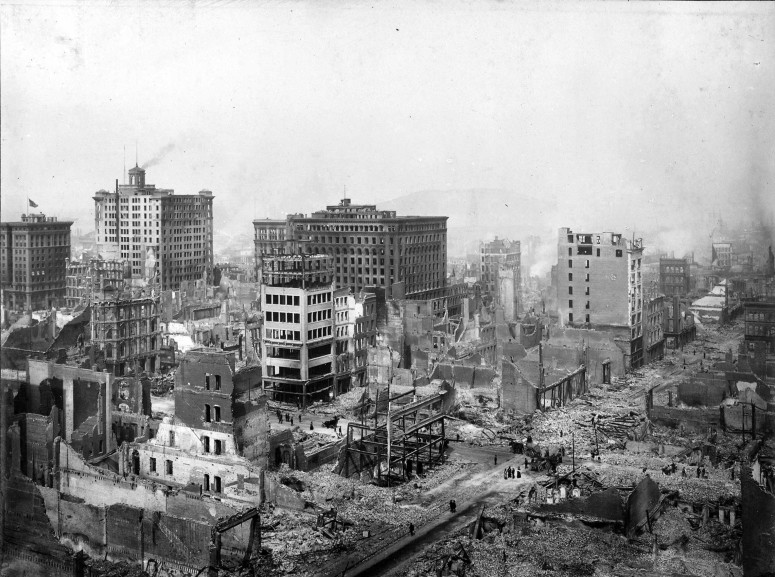
San Francisco earthquake of 1906: Ruins in vicinity of Post and Grant Avenue.
Prepping, in turn, focuses on the idea of life in a collapsed modern society. While the Zombie Apocalypse is a popular Hollywood scenario, more realistic scenarios are natural distasters and war, or a future slow societal collapse resulting from peak oil, water shortage caused by draught or failed water systems, and the always feared plague.
Some people are already preparing for such scenarios, something which is also often advised by Civil Defence organizations; that everyone should be self-sufficient enough to be able to live for three days without access to fresh water, electricity or food.

Harvesting in Haverö, Sweden using home made rakes, standing in front of houses most likely built by the inhabitants and their fellow villagers. Early 1900s
Commonly this involves collecting items that are good to have in such a life, like water filters and canned foods, but prepping also emphasizes the need to be able to travel over distance, returning from work to one’s home, or leaving one’s home for a prepared safe place, with a basic kit carried in a car or on one’s person, commonly called bug out bags, get home bags and everyday carry kits.
This also includes learning how to create electricity, carpentry, preparation of wool and weaving, hunting & fishing, growing crops and managing livestock and basically all that is involved in returning to the simpler life people led pre-industrialization.
The Law
In judicial terms, prepping is also different to both bushcrafting and survivalism, since it assumes a breakdown of society, meaning either a state of emergency or a complete breakdown where no means of upholding a law exist, possibly even a state no longer existing. So while preparing for this is regulated by law, you are actually preparing for a life where no real execution of law might exist.
Time
Here prepping is similar to survivalism as it very much focuses on time. The very name indicates it; preparing (beforehand). The idea is to be self-sufficient when shit hits the fan and everything falls apart, and to be able to live comfortably with as little change in daily life as possible. Consequently time here revolves around longterm solutions thought out beforehand.
Location
Like with bushcrafting the spot is chosen, but here even more carefully selected as it is normally intended for longterm staying, even permanent for life. Safety and sustenance are key words for prepping location.
Consequently fertile soil, clean water, firewood, sewage & latrine, wildlife, fish & game, proximity to cities and neighbours etc are all important factors that are all weighed in in the choosing of location. Of course current finances are also hugely important in this.
A special factor that comes into play here is the Get Home and Bug Out scenarios. In the first the catastrophy takes place while away from home and travelling home by normal means may prove difficult. Likewise the Bug Out scenario, travelling to the safe house can require the same, having to rely on travelling on foot or a bike. For this reason escape routes between these locations may also be planned beforehand, taking speed into particular consideration, even looking at passing through areas normally not allowed to pass.
Moving & Navigation
With prepping moving is tied to two things; returning to home or leaving it by own power, and after the collapse; travelling in a self-sustained manner that is not reliant on petrol. While extremists may build mobile forts, more reasonable preppers prepare bikes with carts and bike bags that can carry gear. Of course a horse will also always be a good means of transportation of persons and gear.
Navigation is naturally of less importance as the areas are well-known beforehand through preparation.
Preparation & Gear
Again, this is the very name of this group and it requires a lot of careful planning, including all the aspects that true self-sufficiency involve. This means learning both skills and knowledge, but also investing a lot of time and money into building or preparing current housing for emergency on a large scale, bunkering up on food, water, diesel & gasoline, a generator, hunting & fishing gear, seeds, tools and manufacturing gear. It is a very deep commitment that means a changed lifestyle.
For the prepper gear needs to be reliable, but can be quite specialized for different tasks, which is quite different to the needs of the survivalist, even if the bug out bag of the prepper is similar to the Every Day Carry kit of the survivalist. As the prepper will mostly remain stationary in their safe place, a large amount of gear can also be stored there. For many though, it requires some considerations for clever storage, especially those living in urban environments. Storing goods however also commonly leads to a concern for a risk of others exploiting it in an emergency, for which reason secrecy and protection are also often considered.
The gear needs to fulfill the longterm needs of life in simple conditions, but can be quite different and specialized for living as a farmer or hunter/fisher or for scavenging collapsed cities, breaking into buildings and abandoned cars.
Ideally, the equipment should also be able to maintain and repair with simple means, with knives not relying on expensive diamond or ceramic sharpeners etc.
Knife features
For rural preppers, the needs are in this case very similar to those of the bushcrafter, with the added requirement that simplicity of maintenance is even more important for someone who needs to be longterm self-sufficient. Other than that, the knives will be specialized for specific tasks, as that gives best performance for the context.

The Chimera by the Ontario Knife Company, with serrated edge and a glass breaker on the pommel
For urban prepers however, the needs may be quite different as the materials they will commonly be working with are of a different nature. Cutting through synthetic and natural rope, fabrics, cardboard, plastics, prying doors and lids open, piercing cans and breaking glass and more will perhaps be more important tasks than carving wood and preparing food. Consequently, a serrated edge which commonly is a bad thing for a bushcrafter, may well be a good feature for the urban prepper. Likewise, a glass breaker which is useless for a bushcrafter, would be quite handy for an urban prepper. An example of such a knife, is the one depicted above, the Chimera by the Ontario Knife Company, which we, surprise, surprise, have also reviewed.
Natural resources
Resources in this case can come in two forms; man made or natural. For the former, it includes exploring and scavenging urban areas for stocked goods and materials in abandoned homes, warehouses, factories and vehicles etc.
In the latter it means farming with growing crops and keeping livestock, making flour from grain, collecting and preparing wool, fur and skin, preparing animal fat and wax for leather and wood treatment or candle making, extracting oil & alchohol for food preparation or fire, extracting salt for food conservation, collecting honey from bees, milking cows and goats, preparing butter & cheese, using wood and metal as resources for tool making and maintenance, and many more traditional skills.
Communication
In a broken down society communication would have to revolve around radio, so here we are speaking of non-digitial radio transmitters/receivers powered by diesel generators or battery. Also walkie-talkies would be useful for a group of people when exploring or hunting.
However, society would likely not break down overnight and a regular radio and tv receiver would also be important, to keep updated with current larger events.
***
This has been a fairly brief, yet still quite wordy exploration of the differences between these three superficially similar groups. While they share a lot of knowledge and skill sets, I hope I have managed to show how their particular contexts and needs also put different requirements on the type of gear that is required as well as on how preparations need to be made.

